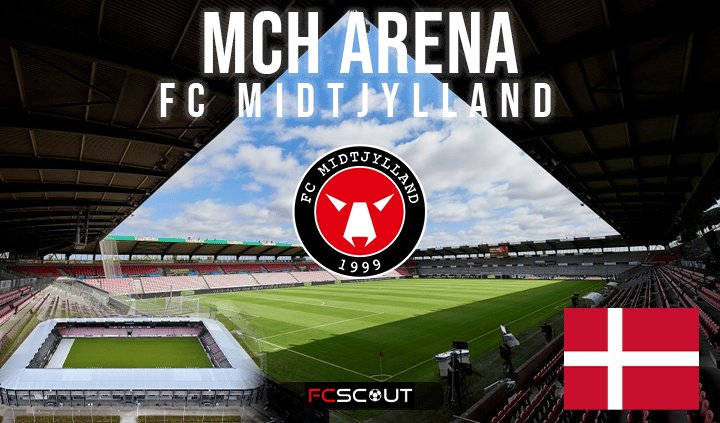MCH Arena: Guide to the Home of FC Midtjylland
FC Midtjylland is a Danish professional soccer club that plays its home matches at MCH Arena, a soccer-specific stadium located in Herning, Denmark.
FC Midtjylland Stadium
The CEO of Messecenter Herning A/S (now known as MCH Group A/S), Georg Srensen, presented Vision 2025, a comprehensive development plan for the company’s next 25 years, on November 1, 2000. This plan also introduced the idea of building a stadium. Despite strong opposition from one of the team’s parent clubs, Ikast FS, the board of the then-newly founded FC Midtjylland decided on November 29, 2000, to move the team to a new modern stadium in connection with the exhibition center in Herning. The board reasoned that a stadium located at Hammerum between the cities of Herning and Ikast would not have the same possibilities and visions.
The stadium and its facilities were leased to FC Midtjylland under a lease agreement with an annual renewal clause on February 4, 2003, at a press conference held at Messecenter Herning. The stadium was to be part of a large commercial and entertainment complex with a capacity of more than 10,000 spectators. It would be built south of the exhibition center’s existing buildings, close to 15,000 parking spaces, and an upcoming highway intersection.

The club’s administration and the official supporters club’s offices are located in a three-story main building that is integrated with the stadium’s main stand in the western section. It also has a double-high foyer, player and referee changing rooms on the main floor, a VIP lounge with a restaurant on the second floor, press rooms on the first floor, sky boxes on the second floor, and a club shop (Ulvesho).
The main entrance to the stadium is highlighted by three tall red concrete structures. Commentator boxes, a camera platform, and separate VIP rooms are on the top floor. Four ticket doors, one in each corner of the athletic complex, allow fans access to the freestanding staircases leading into the stands. The turnkey contractor KPC Byg A/S utilized 7,000 tonnes of concrete to build the 17,000 m2 stadium, and Midtconsult A/S served as the consultant engineer.
The complete grass field, which measured 111 x 72 meters (about 8,000 m2) and included a 104 x 65-meter football field, was installed in the fall of 2003 by the Aarhus-based company Dan Jord in collaboration with Hedeselskabet A/S and allowed to grow firmly throughout the winter. Along with 27 km of heating pipes spaced at 30 cm intervals, 800 m of water pipes, 2,100 m of drainage, and 800 m of drainage were also constructed beneath the grass turf. A cutting-edge sprinkler system was incorporated into the grass, rising above the lawn as the water pressure increased.
The Kobra Arkitekter A/S architects in Herning, Denmark, who later merged with rstiderne Arkitekter A/S in May 2008, looked for ideas during on-site visits at the Camp Nou, Philips Stadion, and Amsterdam ArenA. To create a more intimate atmosphere, the stadium’s corners above the large gates were walled off. The stadium’s structural support is made up primarily of unfinished concrete and steel, demonstrating the simplicity with which it was built and the resources were used. The club requested that the south and north stands be standing-only areas, with seats in red being installed solely in the opposing eastern grand stand and the main stand, with the option of constructing additional seating on the terraces if needed, up to a total of 10,500 seats.
Depending on demand, the home fans and fan club members would occupy the south standing-only stand and would also be given access to half of the north stand. The east standing section of the north stand would be reserved for visiting supporters of the guest teams, who would be separated from the other spectators by a fence. The base of the stadium provides for an increase in capacity of up to 50,000 spectators, and the roof might be raised in such a case to accommodate further growth.
Large free-standing steel columns supplied by the Brabrand-based business Richard Thomsen A/S support the roof, which is made up of black lightweight trapez steel plates covering all four stands and providing the only partition against the stadium’s exterior.
In front of 11,083 fans, FC Midtjylland played Akademisk BK in the 2003–04 Danish Superliga. The game ended in a 6-0 victory for FC Midtjylland, with Mohamed Zidan scoring the game’s first goal just five minutes into the game. FC Midtjylland, who had been playing all of its games at Ikast Stadium in the fall of 2003, which had a 12,000-person capacity and a modest grand stand with 1002 seats, is now relocating to Herning. The new stadium and the players’ improved on-field performance both significantly increased the average attendance.
In the second round of the 2004 UEFA Intertoto Cup, Esbjerg fB and OGC Nice played the first European match at the new site on July 3, 2004. The stadium’s initial capacity, which was around 12,500 spectators with 7,500 seats, was lowered to 11.432 people with 7,070 seats as a result of reconstruction after 2007. The facility hosted its first international football game on August 16, 2005, pitting the Danish national under-21 team against an English team.

